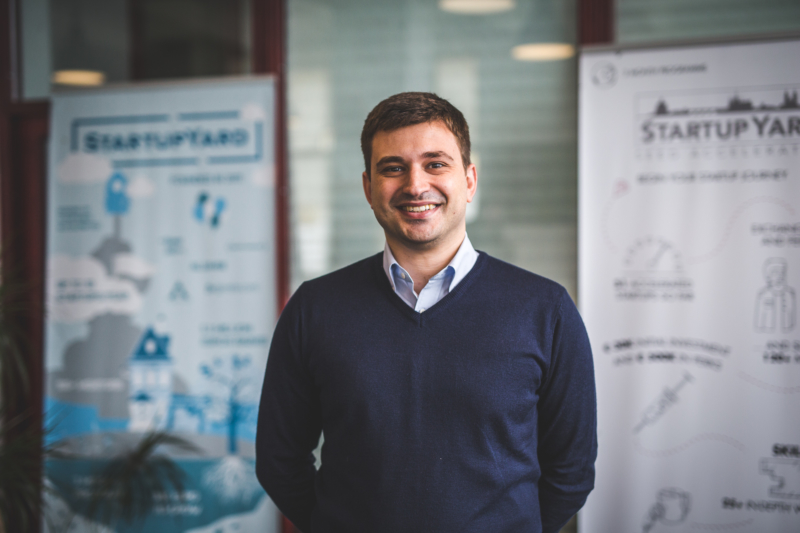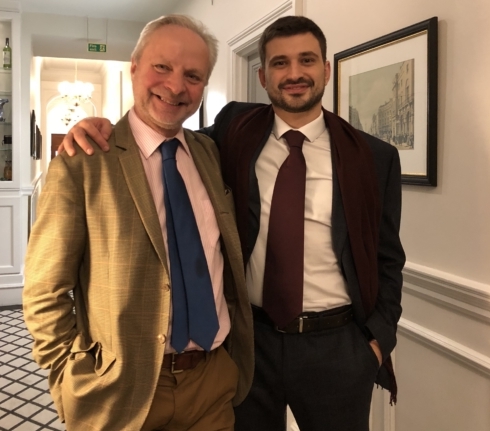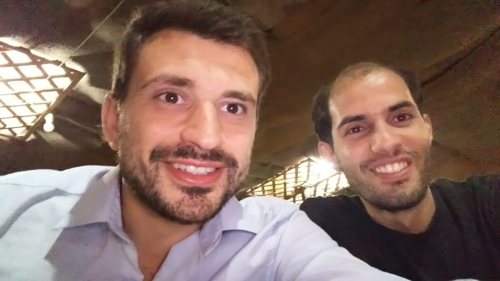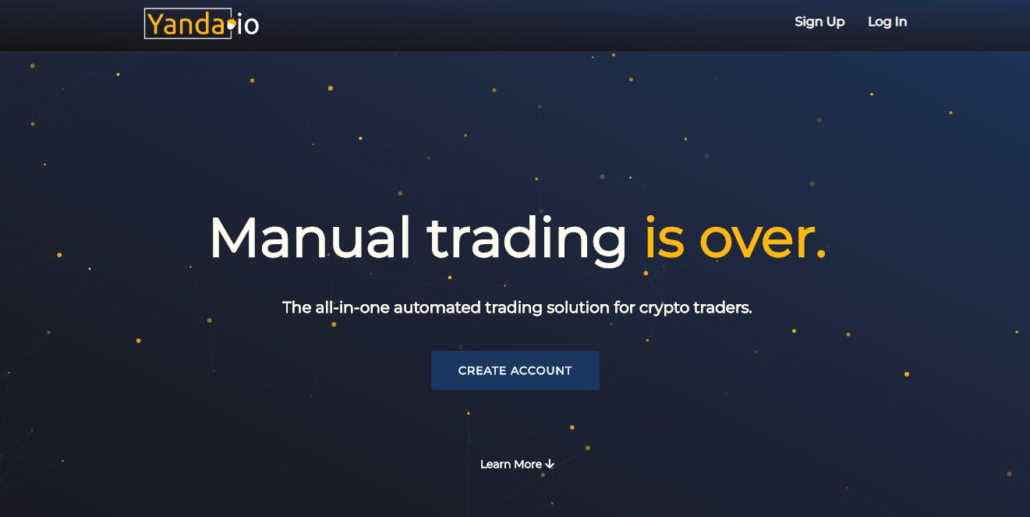When we announced StartupYard Batch X last week, we noted that 3 of the 7 companies that join us this round are working in the field of crypto asset trading. Yanda is one of them, providing cryptocurrency trading novices and pros the opportunity to create and share trading strategies, and control their crypto assets from a single platform, without having to deposit their funds into a single exchange.
Founder and CEO Mario Stumpo is a LUISS Guido Carli University graduate, where he obtained two Master’s degrees, in Law and Economics. He also studied at London School of Business and Finance, where he achieved a PGC in Finance. Mario started his career in Rome, working as a tax adviser for some of the leading Italian firms. After discovering cryptocurrencies in 2012, he developed several algorithms for trading and predicting the value of currencies.
I sat down with Mario this week to talk about why he got interested in crypto assets and cryptocurrencies, and what the future of Yanda looks like.
Hi Mario, tell us a bit about your personal journey towards founding Yanda. How did you get here?
I started really paying attention to cryptocurrencies while working as a tax advisor in Italy, and attending my second masters in economics. At the time, I was cooperating with law firms, chiefly as a tax advisor. I was investigating mechanisms of money laundering (not to help them launder money!), and in this way I came across Bitcoin in the early days of 2012.

Mario Stumpo, Founder and CEO of Yanda
I was particularly looking at the Maradona case. I wanted to understand how these tax avoidance and laundering schemes were evolving in the football industry. I was advising football teams on how to avoid these issues and to avoid even the appearance of impropriety. Working with the financial authority of Italy and with private law firms, we helped football teams to structure their finances correctly, as there were many poor practices in the industry and surrounding it.
Bitcoin was then as now a target for money laundering. I started to see that there was a decreasing interest in the US Dollar as a target for laundered money. Money laundering is as old as money. It never goes away, so I knew that if there was going to be financial activity happening on the blockchain, then money laundering would be at the core of that from the beginning. That’s what drives many new financial technologies and assets. But I was thrilled by the idea around blockchain, to decentralize the monetary and economy system is to fundamentally change the way things work.
Everyone was talking about cutting out 3rd parties that are a huge cost center in the financial world. Particularly in Italy, middle-men institutions can kill deals by adding so much overhead cost to them. Fees are the name of the game. With decentralization, this power to tax the system on the part of central players would be at risk.
So I decided my studies weren’t done, and I moved to London where I had been in 2011 after doing a masters in law. London seemed like the right place to start my journey. I got a uni scholarship to study finance, and between 2012-2014 I got involved with bitcoin, making my first trades. I had started working as a trustee for a Tax and Finance firm, then moved on to working in the forex business. I built a lot of lasting relationships there that still come in handy today. As I began to understand the forex market, I saw that there were two sides to it: two ways of making money. Either you are in execution, or profit seeking. Either you help people execute their trades, or you try to outsmart everyone else with your trades.
All the money the forex traders make is based on volatility. And I realized that cryptocurrencies have the same qualities. I began coming up with some econometric models of the crypto markets, lots of predictive analysis, and started looking at patterns, all starting in 2014. I began trading with this approach, and making some money. In January 2015, I got to know Jonathan Price as a lecturer of mine. Everyone in the academic community was talking about Bitcoin being a pure bubble, and they weren’t interested. But Jonathan heard me out, and kept an open mind.

Mario with mentor and investor Jonathan Price
I showed him my results, and my system which was just Excel at the time. I pitched him the idea of a fully automated trading platform. I hadn’t even learned Python yet. He gave me 200 quid and said, “come back in month.” When I came back, I gave him 350 quid, which was the principle and profits. Ok, it could have been luck as far as he knew, but I convinced him that my approach was just based on consistent thinking and econometric analysis. It’s nothing fancy like machine learning. It’s not magic. It’s just math.
Jonathan opened up his network at London School of Business and Finance and Imperial College London. I gave some lectures, got to know the dean, and eventually Steve Bailey joined my team. He was an investor in startups going back to the early 2000s. By the end of 2015, we had a prototype, and Jonathan came into my office and said: “ok, quit your job, and let’s build this.” Since then I’ve been building Yanda, the team and the products.
Samir Allous joined Yanda as our CTO in early 2016, and together we have been able to go from prototype to registered users without a hitch. His approach and ability to solve problems efficiently is the perfect match with me, and let us achieve great technology results.

Mario with CTO Samir Allous
We have a couple thousands users already using the platform, and we’re working on new things all the time.
What do you think is the biggest problem right now in the cryptocurrency market, and how does Yanda help solve that issue?
The main problem is not just the wild volatility that you see in prices and across exchanges. It’s really, sorry to say, the fact that the market is full of crooks. It’s full of people in it for all the wrong reasons, and it’s just become a big messy bubble.
Whenever you say that, lots of people react and say “you don’t know anything, you don’t understand what we’re doing.” Ok, maybe not. Or maybe I do know something. On the other side, I believe that there are lots of researchers and people like myself trying to nurture an environment where cryptocurrencies are really useful and play a needed role in the economy.
Then on the other side, you have people who are mostly interested in creating that volatility which is going to allow them to squeeze money out of unsophisticated investors. Over the Counter exchanges, totally unregulated, mean that the more money you have, the better infrastructure you have, and so you can make more money. That’s really just the way traditional forex works anyway. The ones who own the systems make the money.
So what we see now is a huge bait and switch. People bring a nice optimistic idea to the market, they promise investors to get rich quick, then they find out building value is just as hard as it always was. At the end of the day, having a coin is meaningless if you cannot build great products on top of that. Then you’re just selling tickets to a party that has no music. People think the coin has value, but when they eventually try to use it, they find out it doesn’t.
Our knowledge space is polluted right now, and people don’t understand what is really driving the market. That’s why we want to provide a tool for approaching the market, and sharing real working knowledge about cryptocurrencies. That’s what Yanda is all about: fighting disinformation, and cracking the wall of lies and promises that get built around a lot of cryptocurrencies.
Let’s also talk about Yanda coin. How does having your own token help Yanda execute its mission of helping retail investors to make crypto profits?
That’s a great question. Because I just got done saying how coins are being used all wrong – to sell something before it is even built. Well, we did Yandacoin the other way. We built a system and a set of tools for people to automate their crypto trading the traditional way.
We built this essentially as a SaaS service, however to distinguish it from any other such service, we realized that we needed to have a transactional model. We needed to charge users for the volume of their use, because otherwise you are not providing the right incentives for trading only at the right times. Unlimited use allows people to game the system, perform front-runs, pumps, etc. Pay-per-use is much more honest.
However, the cryptocurrency system is expensive to use in this way. Pay-per-trade costs users quite a bit of money over the long term, because not only do they have to pay us, they have to pay the cost inherent in the coins they are trading as well. So we came up with Yandacoin, which is a way for us to allow users to pay for our services on a per-use basis, and at the same time to batch their transactions with those of others, and save on the execution of their trades as well.
The main reason for running our blockchain on the multi-chain protocol is because we can cut all the expenses related to third parties when it comes to transferring funds from one wallet to another. The major value comes out of our blockchain, intended as a fully auditable ledger where we store all the data related to trader performance across multiple exchanges. Storing these data within our blockchain guarantees enhanced transparency about the performance of Yanda traders.
We can do this because we are built on the open source Multichain stack. Our platform is a real database: and it can be decentralized, distributed, or private. That provides complete transparency to our users about how their transactions are processed. We have nothing to hide from anyone, and it will always be abundantly clear how and how much we profit from our activities. All data we collect is accessible to anyone with the blockchain.
We began to realize that we can function as a layer on top of the exchanges, which creates fully transparent and auditable databases for our users, who access exchanges through our platform. We serve to provide visibility to our users, and helps them to maintain auditable records for themselves as well.
Tell us a bit more about how your platform works, and why people should use it instead of others.
The way you use the platform really depends on your experience level. Our main tool is dubbed PATS, which si the Personal Automated Trading System. That is aimed at experienced traders who know what they’re doing, and are setting up strategies they would like to automate and use more often.
The advantage of using our platform to do that is that it’s completely safe. We never have withdrawal permissions from the exchange APIs, so we cannot move our customers’ funds out of exchanges. We don’t take a deposit, and we have no access to customer funds. Traders can create custom strategies from scratch, and we don’t offer strategies ourselves.
However, we want to provide the opportunity for experienced traders to leverage their strategies and help less experienced members take advantage of them as well. So the social trading feature allows novices to copy strategies of successful traders, for which a commission could be earned. We let them establish a relationship and talk to each other, explore each other’s profiles and compare different traders to learn about common practices.
In order to activate an account with Yanda, traders must provide their API keys (with no withdrawal permissions) from at least one of the available exchanges. Once they are settled with their keys, traders can opt for three solutions: Copy the trading strategies created and shared by other traders, Manage their crypto portfolio across multiple exchanges, or create their own trading bot with no coding needed.
We plan to offer a more comprehensive portfolio management tool as well, so that our users can see past trends and how they may affect the future. These are all standard analysis practices. There’s no secret sauce to doing it, it’s just being applied to crypto instead of to more traditional assets.
How to explain my approach? I’m a big fan of Bill Gates. I try to follow his example. What he did was catch great ideas from open source, and offered tools that were accessible to everyone. Like Excel: a tool to let you do whatever you want. From a simple calculation to a complex program. We have the same aim with Yanda: from trading a few coins, to having a comprehensive portfolio strategy, we want to provide that scalability to our users.
Where do you see the project in 5 years time? Do you see crypto and traditional stock investments each playing a role in Yanda’s future?
It may sound surprising, but we want to be a bank, more or less. We want to compete with companies like Revolut and Wirex, which are approaching the market from a different set of core values. Revolut is all about convenience of payments in real life and between individuals. Wirex is about foreign exchange and sending money. We will be about trading, but each of us will function as banks.
We have the right infrastructure, the ambition, and the right team to build the bank of the future. We will become a regular licensed broker, and wealth manager, but we will also offer, as Revolut has in its own way, a new conception of finance. The main difference is that we will be a “bank” that doesn’t hold the funds our members trade. We will create a bridge between their wallets and funds on multiple exchanges.
In some way, it’s almost the reverse of Revolut: they offer the advantages of having one account but being able to access dozens of different countries and currencies with that account. We offer the ability to take a bunch of accounts, and to localize them in one account. Where they help you spread out, we help you collocate.
I believe that the banking system ought to go back more to the way it was in the 80s and 90s. That is to say, more along the lines of the European socialist model of savings banks. Banks should just hold money. They shouldn’t function as “financial product” providers or investors. Those tasks should be taken up by someone who does not have your money in hand. The combination is a dangerous one, as we have seen in recent history. Centralized power and vertical integration doesn’t lead to broad social benefits. We seek horizontal integration instead: the services of a bank but with lower overhead and higher security.
Yanda is an ambitious project that aims to offer other services that includes wallets for Bitcoin and other cryptos, a wealth management system, and a debit card for traders. Currently, one of our main focus is regulation. We still don’t know how all governments will react on the long run, but after the latest report from the FCA we foresee opportunities we would like to catch. Regarding the inclusion of traditional stocks within Yanda’s services, we are open to it but our current focus is on cryptocurrencies and is going be like this until we will obtain the necessary licenses to operate with other assets.
What do you think the cryptocurrency market has to accomplish before it can become a really reliable and stable part of the financial system?
The forces that might influence the future of cryptocurrencies are various and hostile, but the recent trend of issuing so-called “stable coins” (cryptocurrencies backed by fiat currencies) such as the USDC is an encouraging measure of success of the blockchain technology. Whether Bitcoin is going to succeed as a global currency or not, the worldwide adoption of the blockchain as a distributed ledger will follow a separate path that seems more realistic and feasible to me (especially in the short term).
How can people get involved with Yanda and start using the services today?
The steps are very easy, actually. Traders can register for free on Yanda.io and start trading immediately after they connect their account with exchanges via API keys. People who want to perform cross-chain swap can also use CryptoYou which is built on top of Yanda. We are now working on improving the usability of the platform and on the production of video tutorials that will help users with their journey on Yanda.
You’re among the first startups that have joined StartupYard from the cryptocurrency world. Have there been any big surprises coming through the mentoring process at SY?
It is an honor to me and to all the members of the team at Yanda to be part of SY. The biggest surprise is to see so many top managers with a more traditional financial background getting closer to our world. Having the opportunity to share our vision with them and receive their feedback is definitely a major opportunity for understanding how we might fit in this evolving industry.
For you, which of the StartupYard mentors have been the most influential, and why?
It is very difficult to determine that because every mentor brought her/his own point of view and are all very different and valuable. If I need to choose, Gustavo Vizcardo, Yann Bouvier and Philip Staehelin have been sharing their expertise with us since we met and helped us drawing a solid plan of expansion and growth.





